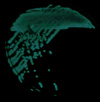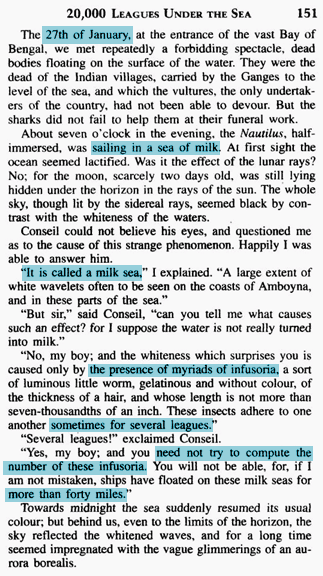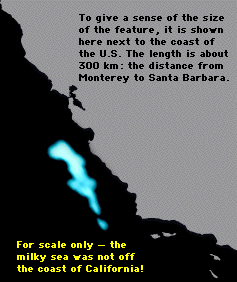 Composite image of earth atlas information and milky-sea data. The bioluminescent feature (lower right) is to scale, but has been colorized and enhanced, so it appears much brighter in relation to the scene than it would naturally. (Do not use this image without permission.) Spotting a bioluminescent milky sea from space  Milky seas are unusual phenomena which have been noticed by mariners for centuries, but which remain unexplained by scientists. These events are when the surface of the ocean, often from horizon to horizon, glows with a continuous uniform milky light. Although the origins of this light are not well investigated, the most plausible explanation is that it is caused by blooms of bioluminescent bacteria. Dinoflagellates, which cause red tides, flashing waves, and sparkling wakes behind boats, need to be physically stimulated to produce their brief bright flashes.
Milky seas are unusual phenomena which have been noticed by mariners for centuries, but which remain unexplained by scientists. These events are when the surface of the ocean, often from horizon to horizon, glows with a continuous uniform milky light. Although the origins of this light are not well investigated, the most plausible explanation is that it is caused by blooms of bioluminescent bacteria. Dinoflagellates, which cause red tides, flashing waves, and sparkling wakes behind boats, need to be physically stimulated to produce their brief bright flashes. This type of display does not match the kind of display seen in milky seas. Bacteria, on the other hand, will glow with a continuous light, under the right conditions. This type of display does not match the kind of display seen in milky seas. Bacteria, on the other hand, will glow with a continuous light, under the right conditions. The important part of the explanation above is the phrase under the right conditions. Bacteria need to reach very high concentrations (10e8 cells/ml) in order to accumulate the chemical that induces light production, and many scientists believe that such concentrations will not occur under natural conditions. The most likely luminous species is Vibrio harveyi which has been reported in moderate concentrations from luminous waters of the Indian Ocean (Lapota, et al., 1988). Until a scientific expedition can sample waters from within a milky sea, we can only speculate how and if these concentrations of bacteria can be attained. The important part of the explanation above is the phrase under the right conditions. Bacteria need to reach very high concentrations (10e8 cells/ml) in order to accumulate the chemical that induces light production, and many scientists believe that such concentrations will not occur under natural conditions. The most likely luminous species is Vibrio harveyi which has been reported in moderate concentrations from luminous waters of the Indian Ocean (Lapota, et al., 1988). Until a scientific expedition can sample waters from within a milky sea, we can only speculate how and if these concentrations of bacteria can be attained. Nonetheless, we believe that given the rare occurrences and limited geographic range of these events, that it is plausible to consider special circumstances might lead to such a bloom of bacteria. After all red tides are exceptional conditions which can have 1000x greater densities of cells than are found naturally in the water. Why can't there be "blue tides" of glowing bacteria when the right combinations of nutrients, temperature, and oxygen coincide? The light from a milky sea is sometimes described as white, but it is actually blue. It may appear white when detected by human night-time vision, using rod photoreceptors that do not distinguish colors.  We were recently able to capture the first satellite images of a milky sea -- and of bioluminescence at all, to our knowledge (Miller, et al. 2005). The image above, prepared by Steve Miller of the Naval Research Lab, shows a composite of two different earth atlases (day and night) with actual cloud data and the satellite-detected bioluminescence superimposed. The milky sea data have been colorized to approximate the natural bacterial emission spectrum, since the low-light sensor only perceives light as grey scale. In Jules Verne's 1870 novel Twenty Thousand Leagues Under the Sea the submarine Nautilus spent at least a few of those eponymous leagues (one league = three miles) traveling through a milky sea.  The parallels between his fictional account, which must have been based on a real report, and our recent observations almost defy coincidence: The parallels between his fictional account, which must have been based on a real report, and our recent observations almost defy coincidence:
|
||
|
References and Additional Reading:
|
 .
| Research forum | Bioluminescence Info Page.
.
| Research forum | Bioluminescence Info Page. The satellite data were collected on 25 January 1995. In a ship report from the same night, the captain reported sailing into the milky sea and then out of the other side ... 6 hours later! The positions he reported match precisely with the edges of the feature seen by the satellite. The event was detected by the satellite again on the nights of the 26th and 27th.
The satellite data were collected on 25 January 1995. In a ship report from the same night, the captain reported sailing into the milky sea and then out of the other side ... 6 hours later! The positions he reported match precisely with the edges of the feature seen by the satellite. The event was detected by the satellite again on the nights of the 26th and 27th.